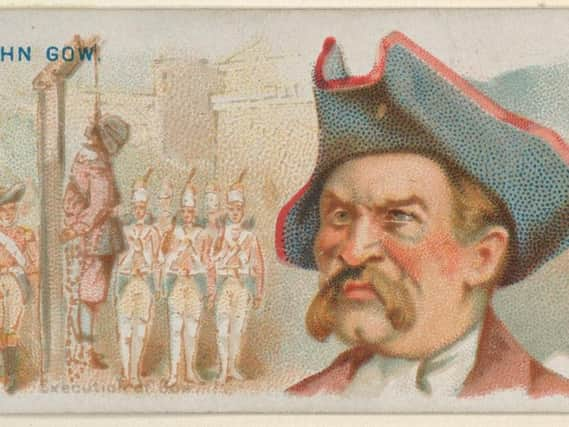John Gow: who was Scotland's most infamous Scottish Pirate and author of The Pirate Code?


But among the great and the good, there are also those individuals who made their names for other, more sinister reasons.
One of those people is John Gow, one of the most influential pirates to ever sail the seas.
Advertisement
Hide AdAdvertisement
Hide AdA Scotsman through and through, Gow was born in Wick, Caithness around 1698, although the exact date of his birth is unknown.
In fact, very little definite information is known about Gow’s life. Only a handful of historical sources contain information about the pirate, and many are not thought to be completely reliable by historians.
The Pirate Gow by English writer Daniel Defoe is considered a fictionalised version of events, merely inspired by Gow’s true life. Meanwhile, an account by a Mr. Alan Fea – a decedent of his captor published nearly two centuries after Gow’s death in 1725 – is hardly a first-hand account.
As a child, Gow and his family moved to Stromness, Orkney, where he was raised; it was here that he learned to sail a ship.
A pirate’s life
Gow’s days as a pirate were short lived, and only lasted for a year or so before his capture and subsequent execution.
They began in 1724, when Gow – as a member of the crew on a voyage from London to Lisbon and back – plotted a mutiny and planned to take control of the vessel for himself.
He was unable to find enough fellow members to back him up in his efforts, and so the plan failed miserably.
That didn’t stop word about his plans getting out, and the Scot fled to Amsterdam to escape the rumours of his piratical intentions.
Advertisement
Hide AdAdvertisement
Hide AdHis first success came shortly after when, as second-mate of the ship Caroline en route to Santa Cruz, plans for another mutiny were hatched.
With complaints about the on-board rations running rife, morale was low among the vessel’s crew, and they began to disobey captain Freneau’s orders.
Sensing a mutiny, Freneau and his mate stashed some small arms in the cabin, so that they would be able to defend themselves in case of an uprising.
Not realising that Gow was the ring-leader of the attempted coup, Freneau ordered him to prepare arms, but that night, the mutineers sprang into action.
With shots ringing through the air, Freneau was told that one of his crew members had fallen overboard and rushed out on the deck where he was stabbed in the neck and shot in the stomach twice by Gow.
The mutineers tossed him seaward but, still alive, Freneau was able to clutch to a rope hanging from the side of the ship.
It wasn’t long until the rope was cut, and the captain fell into the brine, never to be seen again.
The next morning, the remaining crew members were given the option to follow in their captain’s footsteps or join the dissidents. reportedly, all of them chose their former position, but Gow and his band of troublemakers renamed the ship, Revenge.
Caught in Orkney
Gow was eventually captured in Orkney in 1725.
Advertisement
Hide AdAdvertisement
Hide AdHe’d returned to his home after running low on supplies and with the authorities hot on his tail. And though he’d adopted the alias ‘Mr. Smith’ and was posing as a wealthy trader, a passing merchant soon recognised him.
Surrender wasn’t an option, so Gow and his crew instead raided the Hall of Clestrain, which filled them with an arrogance to attack another remote mansion. This time however, they ran aground and were captured.
Gow was hung for his crimes at the Execution Dock in London, and the bodies of he and his crew were tarred and displayed upon the banks of the Thames as a warning to those looking to replicate Gow’s deeds.
Writing the Pirate Code
While different ships and crews had different pirate codes of conduct – meaning there really isn’t a definitive 'Pirates’ Code' – Gow’s interpretation is notable.
Here are its rules:
I. That every man shall obey his commander in all respects, as if the ship was his own, and as if he received monthly wages.
II. That no man shall give, or dispose of, the ship's provisions; but every one shall have an equal share.
III. That no man shall open, or declare to any person or persons, who they are, or what designs they are upon; and any persons so offending shall be punished with immediate death.
IV. That no man shall go on shore till the ship is off the ground, and in readiness to put to sea.
Advertisement
Hide AdAdvertisement
Hide AdV. That every man shall keep his watch night and day; and at the hour of eight in the evening every one shall retire from gaming and drinking, in order to attend his respective station.
VI. Every person who shall offend against any of these articles shall be punished with death, or in such other manner as the ship's company shall think proper.
The code was reportedly found aboard the George (the renamed Revenge designed to give the ship an inauspicious moniker) shortly after Gow’s capture. Historians believe that Article IV's reference to no going ashore "till the ship is off the ground" suggests that the ship was already grounded when this code was written.
